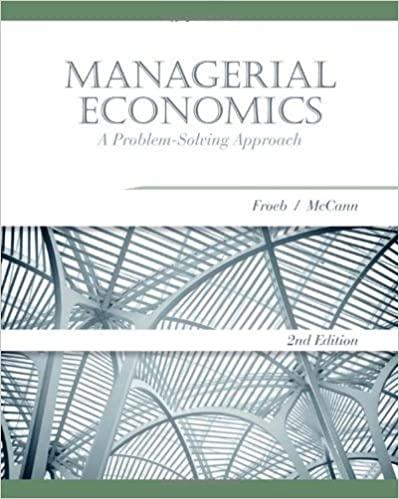Question
PLEASE DON'T ANSWER THE QUESTION: I WOULD JUST LIKE TO KNOW HOW I CAN GET STARTED WORKING ON A PROBLEM LIKE THIS AND A STEP-BY-STEP
PLEASE DON'T ANSWER THE QUESTION: I WOULD JUST LIKE TO KNOW HOW I CAN GET STARTED WORKING ON A PROBLEM LIKE THIS AND A STEP-BY-STEP GUIDANCE THAT I COULD FOLLOW. THANKS!
Suppose that the following economy consists of two types of people, A and
B, with population 100 for each type. Time is infinite and labeled as t = 1; 2; : : : ;1.
A can only work in the even-period while B can only work in the odd-period.
When they work, they can produce 1 unit of apple. Eating an apple will yield 1 unit
of utility. An apple is nonstorable and cannot be divided. A value apples more
than B in the odd-period, i.e., they want to eat the apple more than B do.
However, B value apples more than A in the even-period.
(a) How does the socially optimal allocation look like? In the absence of medium of
exchange, list the requirements to achieve the optimal allocation.
(b) Suppose that types A and B are anonymous and cannot commit. At the beginning
of time t, each Type A agent is endowed with 1 unit of silver coin. Assume that
other than the Mint, no one can produce coins. The Mint will not supply more
coins at this moment. A coin can be either stored or consumed by people. If
consumed, it will generate 1 unit of utility as well. But after consumption, it
simply disappears and cannot be replaced. Explain the trading pattern and why
coins will not be consumed.
(c) What is the value of a coin? Is it still equal to 1 unit of utility?
(d) Suppose now the agent is able to produce 2 units of apples. But for some reason,
1 silver coin can only exchange for 1 unit of apple. This exchange rate is fixed.
Clearly, there is a liquidity-shortage problem here: people want to consume 2
apples but they can only afford 1. Assume that there exists a bank which only
has a record-keeping technology. The bank can costlessly print (at) paper money,
accept deposits/collateral and make loans. The bank promises to convert 1 unit of
paper money to 1 unit of silver coin on demand. What is the role of a bank in this
environment? Write down the balance sheet of the bank with the unit measured
in terms of coins in period t = 1. What are the liquid assets and illiquid assets
in this economy? Which one is outside money and which one is inside money?
Explain the process for the bank to create and destroy its paper money.
(e) Suppose in one of the even-periods, say t = 4, some of the Type B agents expe-
rience a preference shock: starting from t = 5, they will not consume anymore
(think about they will pass away). What happens to the bank if the size of the
shock is small which affects only 25 Type B agents? What happens to the bank if
the size of the shock is large which affects 75 Type B agents? Determine the size
of the shock affecting how many people would lead to the bank insolvent.
(f) Now the Mint can produce more coins. Can the Mint stabilize the banking sector
in the presence of shock? Explain.
Step by Step Solution
There are 3 Steps involved in it
Step: 1

Get Instant Access to Expert-Tailored Solutions
See step-by-step solutions with expert insights and AI powered tools for academic success
Step: 2

Step: 3

Ace Your Homework with AI
Get the answers you need in no time with our AI-driven, step-by-step assistance
Get Started


